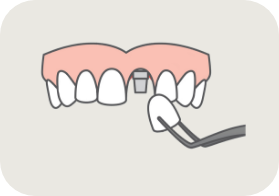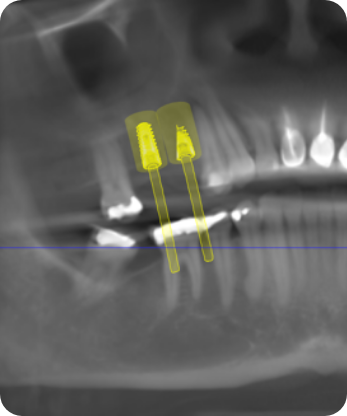Multiple Tooth Implants
Multiple Tooth Implants
Just like one missing tooth, several missing teeth can be
easily treated with multiple dental implants. Implant supported teeth are
permanently fixed in the mouth, unlike removable appliances like dentures. They
don’t slip or click, and there is no worry about them moving or falling out
when speaking, eating, or participating in activities. And because dental
implants are placed directly into the bone, they help preserve the jawbone and
prevent bone deterioration.
Don’t ignore missing back teeth. Losing multiple teeth from
decay, gum disease or neglect will have a domino effect resulting in bone loss
around your remaining teeth causing them to become loose, rotated and mobile.
Don’t be complacent just because your missing teeth are in the back of your
mouth! To avoid the risk of cascading harm to neighboring teeth, your lost
teeth should be replaced as soon as possible with implants.


What are the benefits of implant-supported tooth bridges?
There are several advantages of choosing an implant-supported restoration.
- Improve confidence: Aesthetics play a major role in our lives. Having implants could boost your confidence, allowing you to show-off your new smile.
- Improve function of your mouth: Missing teeth can have a significant impact on the functioning of your mouth. If gaps in your teeth are not restored, it can affect the alignment of your remaining teeth, making them weak. This is why treatment such as implants can restore your bite back to its original form.
- Bone loss: If there are no teeth in place, the jawbone of the surrounding area will eventually disappear because of the breakdown of the cells. Multiple implants maintain the structure of jawbone which also contributes to a healthy mouth.
Having implants placed begins with having a treatment plan made up based upon a detailed assessment of your mouth, gums, teeth, jaw and medical history.
As part of this, CT X-rays may be required to be taken for bone assessment and to guide where the implants should be best placed.
Based on your overall clinical situation, Dr. Rattan will provide you with information about the various treatment options available while also taking your wishes into account.


Single Tooth Dental Implants
A single tooth implant is an ideal solution for individuals who are missing a single teeth. The replaced tooth replaces both the lost natural tooth and its root and will look and function like a natural tooth. You will help be able to regain confidence in your smile. Speak and smile again without worrying about your missing tooth.
An additional benefit to single a tooth implant is that it can help prevent bone loss. This can not be accomplished by wearing a conventional dental bridge. That is because the implant stimulates the bone, through regular chewing and biting, which helps to stave off deterioration of the jaw.

What are the advantages of a single-tooth implant over a bridge?
A dental implant provides several advantages over other tooth replacement options. In addition to looking and functioning like a natural tooth, a dental implant replaces a single tooth without sacrificing the health of neighboring teeth. The other common treatment for the loss of a single tooth, a tooth-supported fixed bridge, requires that adjacent teeth be ground down to support the cemented bridge.
Because a dental implant will replace your tooth root, the bone is better preserved. With a bridge, some of the bone that previously surrounded the tooth begins to resorb (deteriorate). Dental implants integrate with your jawbone, helping to keep the bone healthy and intact.
In the long term, a single implant can be more esthetic and easier to keep clean than a bridge. Gums can recede around a bridge, leaving a visible defect when the metal base or collar of the bridge becomes exposed. Resorbed bone beneath the bridge can lead to an unattractive smile. And, the cement holding the bridge in place can wash out, allowing bacteria to decay the teeth that anchor the bridge.
How Do Single Tooth Implants Work?
Single tooth implants act to replace the entire tooth structure, rather than just a crown or a visible portion of the tooth.
An entire dental implant restoration consists of three main parts:
- Dental implant. This is a titanium screw-like post that is surgically placed in your jawbone. A dental implant acts to replace a natural tooth root and serve as an anchor to the tooth crown.
- Crown. An implant-retained crown is a custom restoration that mimics the missing tooth in both function and aesthetics.
- Abutment. This is a tiny connector that attaches the crown to the dental implant. Abutments are crucial to ensure a stable foundation for your new tooth.

Our Dental Implant Process
WHAT IS THE PROCESS OF OUR DENTAL SOLUTION?
01
Consultation
& Planning
Before the procedure, Dr. Rattan will use advanced technology including CT scans, 3D facial scanners, intra-oral cameras to plan the ideal treatment for patients. Dr. Rattan will also discuss your medical history, current medications, and any current health problems to determine if you are an ideal candidate for oral surgery.
02
Treatment
Plan
Dr. Rattan will present you with your treatment plan and discuss financing options. If you decide to proceed with treatment, your implant placement procedure will be scheduled for a later date. In some cases, a pre-op appointment may also be scheduled to discuss dental sedation, how to prepare, and to go over any prescriptions needed.
03
Surgery &
Placement
The day of your appointment, Dr. Rattan will begin with extraction of any remaining teeth and perform surgical treatment for the placement of dental implants. Four dental implants will be placed in the upper arch and an additional four implants will be placed in the lower arch. These implants will be used to support a temporary denture while the
implant sites heal.
04
Recovery &
Final Restoration
The recovery time is approximately three months. Our caring dentists will explain to you everything about oral care during your recovery period. In the final step, the temporary acrylic teeth are replaced with permanent teeth that are made of sturdy materials.
Frequently Asked Questions
Multiple Teeth Implants can replace a number of missing teeth, without the need for an Implant support under every tooth. This makes it less expensive then replacing every missing tooth with a Dental Implant.
If you are considering Multiple Teeth Implants, you don't need one for every missing tooth. A Dental Implant placed at the end of a span of missing teeth can provide the support for a segment of new teeth.
Cleaning your Multiple Teeth Implants is a little different to your natural teeth or a Single Tooth Implant. The span of teeth between your Dental Implants will need to be cleaned with a Waterjet or Super Floss.
Dental Implants can be placed comfortably under a local or general anaesthetic. There is little difference in terms of recovery between having one or a few Dental Implants placed within the same procedure.
If you are missing most or all of your teeth, or have been living with dentures for a number of years, you can have these replaced permanently with the use of Denture Implants.

- 2955 Corral Hollow Rd #100, Tracy, CA 95376, United States
- office@innovodentalstudio.com
Get Started
- Monday | 10 AM - 7 PM
- Tuesday | 9 AM - 6 PM
- Wednesday | 10 AM - 7 PM
- Thursday | 9 AM - 6 PM
- Thursday | 9 AM - 6 PM
- Friday | 10 AM - 7 PM

